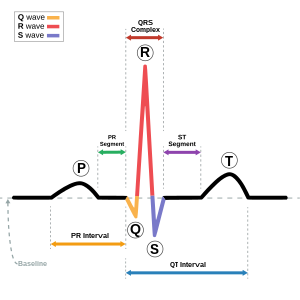Atrial fibrillation
| Atrial fibrillation | |
|---|---|
 |
|
| Diagram of normal sinus rhythm as seen on ECG. In atrial fibrillation the P waves, which represent depolarization of the top of the heart, are absent. | |
| Classification and external resources | |
| Specialty | Cardiology |
| ICD-10 | I48 |
| ICD-9-CM | 427.31 |
| DiseasesDB | 1065 |
| MedlinePlus | 000184 |
| eMedicine | med/184 emerg/46 |
| Patient UK | Atrial fibrillation |
| MeSH | D001281 |
Atrial fibrillation (AF or A-fib) is an abnormal heart rhythm characterized by rapid and irregular beating. Often it starts as brief periods of abnormal beating which become longer and possibly constant over time. Most episodes have no symptoms. Occasionally there may be heart palpitations, fainting, lightheadedness, shortness of breath, or chest pain. The disease is associated with an increased risk of heart failure, dementia, and stroke. It is a type of supraventricular tachycardia.
High blood pressure and valvular heart disease are the most common alterable risk factors for AF. Other heart-related risk factors include heart failure, coronary artery disease, cardiomyopathy, and congenital heart disease. In the developing world valvular heart disease often occurs as a result of rheumatic fever. Lung-related risk factors include COPD, obesity, and sleep apnea. Other factors include excess alcohol intake, diabetes mellitus, and thyrotoxicosis. However, half of cases are not associated with one of these risks. A diagnosis is made by feeling the pulse and may be confirmed using an electrocardiogram (ECG). A typical ECG in AF shows no P waves and an irregular ventricular rate.
...
Wikipedia
